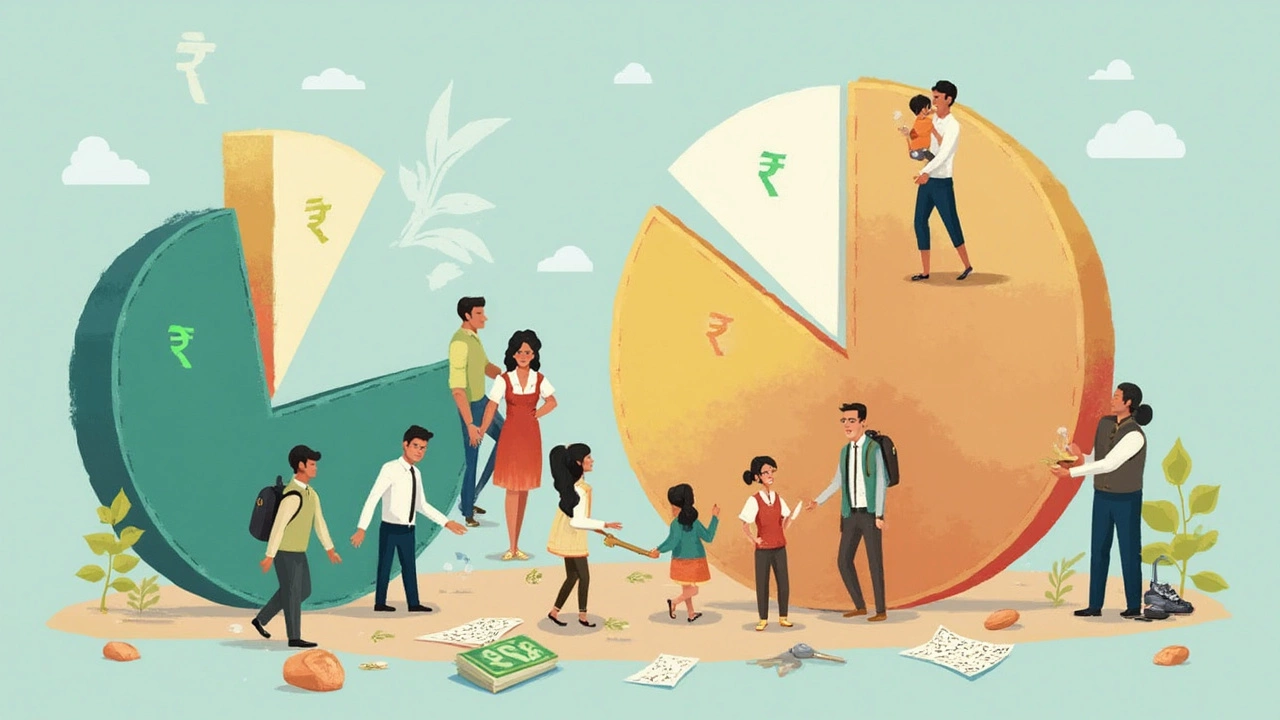The costs of splitting up aren’t just about lawyer fees and moving boxes. For a lot of folks, divorce is the single biggest financial shock they’ll ever face. Think about your rent or mortgage, your Netflix bill, dinner, your kid’s soccer shoes—suddenly, you’re paying all that on your own. Plus, there’s the real gut-punch: losing half your stuff, retirement accounts, and sometimes feeling like your paycheck just shrank overnight.
The numbers tell us divorce rarely leaves anyone rolling in cash, but the load isn’t split evenly. Loads of people assume men walk away richer, but that’s not what’s happening in most cases today. Women, especially moms with young kids, often see their incomes drop by up to 30% within the first year after a split. Meanwhile, men sometimes have to hustle for extra gigs just to cover child support or alimony.
If you’re about to go through it (or already in the trenches), you’re probably asking yourself: How bad can this get for me? Why does the other side sometimes seem to get a sweeter deal? The truth is, there are ways to cushion the landing—if you know where the pitfalls are.
- Why Divorce Hits Wallets So Hard
- Who Loses More: Men or Women?
- Child Support, Alimony, and Hidden Money Leaks
- Bouncing Back: Real Money Tips After Divorce
- What Family Law Attorneys Wish You Knew
Why Divorce Hits Wallets So Hard
Most people don't realize just how much their finances rely on sharing costs. When a couple divorces, all the basics—housing, groceries, car payments—double up. Instead of splitting that $2,000 rent, now each person might pay almost that much alone, especially if they stick close to where their kids go to school.
Legal costs are another killer. The average divorce costs $7,000 to $15,000 per person, but things can shoot up fast if anyone fights over property or custody. Even just sorting out who keeps the coffee table often ends up costing way more than the furniture’s worth.
It’s not just the obvious stuff, either. Here’s what folks usually don’t see coming:
- Unplanned expenses to set up a new home—think furniture, appliances, and deposits.
- Big jumps in health insurance when you’re not on a family plan anymore.
- Hidden costs like therapy for the kids or moving fees if you have to relocate.
- Taxes on assets you split (like retirement money) if paperwork isn’t handled right.
Managing a single income is way tougher after divorce. According to a Pew Research Center study in 2023, divorced households in the U.S. saw their overall wealth drop by around 25%, compared to those who stayed married. The blow is heavier for households with kids.
| Expense | Average Increase After Divorce |
|---|---|
| Housing | +30% to +50% |
| Living Costs (groceries, utilities, etc.) | +20% |
| Legal Fees | $7,000 - $15,000+ |
| Health Insurance | +30% (if losing family plan) |
So, why is the financial impact so rough? It comes down to two things: expenses rocket up, and most people’s income stays the same or even drops. Juggling bills solo takes adjustment, especially if you weren’t the main breadwinner before.
Who Loses More: Men or Women?
This is the big debate, right? A lot of folks assume men come out on top after a divorce, but look at the actual numbers and you’ll see a different story. Across the U.S., women face a way steeper financial drop after a split. Especially mothers. According to the Institute for Women’s Policy Research, women see their household income fall by about 41% after divorce, compared to a 23% drop for men. That’s not pocket change—it’s life-changing.
Single moms get hit even harder. Airtight stats from the U.S. Census Bureau say, two years after divorce, only about half of custodial mothers receive the full child support they were awarded. Meanwhile, women’s odds of falling below the poverty line after divorce are more than twice as high as men’s. Why? Lower pay at work, taking care of kids, losing access to a partner’s benefits—the deck is stacked.
That said, men don’t just skate through. They’re more likely to lose the family house and might have to cough up big monthly checks for child support and sometimes alimony. The money stress can lead to mental health issues or even moving back in with parents for a while. Nobody’s immune when the bills start piling up.
| Financial Hit Post-Divorce | Women | Men |
|---|---|---|
| Average drop in income | 41% | 23% |
| Poverty risk (2 years after) | 27% | 10% |
| Full child support received | 54% (of moms) | 31% (of dads) |
Here’s another thing: older women often get slammed harder, especially if they spent years out of the workforce. Meanwhile, older men’s retirement accounts can take a big hit with court-ordered splits, so they may need to delay retirement.
- If you’re worried about the financial impact of divorce, look at the facts—don’t just go by what your buddy down the street says.
- Women need to plan for possible gaps in support or work. Men might want to prep for losing assets or higher monthly payments.
- Both should avoid making emotional money moves, like selling the house out of spite. That usually backfires.
Bottom line: women generally suffer bigger short-term money losses, but men can see their finances squeezed long-term through ongoing payments. The only real winner? Usually, the lawyers. So getting smart early can make a huge difference.

Child Support, Alimony, and Hidden Money Leaks
Once the divorce papers are signed, the real grind begins: figuring out who pays what, to whom, and for how long. Financial impact isn’t just about splitting the house or cars. It’s the little (and big) bills that no one thinks about until they land in your inbox every month.
Child support always grabs headlines, but not everyone knows how it’s calculated. Most states use basic formulas that consider each parent’s income, how much time the kids spend with each, and big-ticket expenses like health insurance or daycare. On average, a parent paying child support shells out between $430 to $550 a month per child in the U.S. In reality, payments can swing way higher in big cities or if someone has a hefty paycheck.
Alimony (or spousal support) is a totally different beast. Not every divorce ends with alimony payments—only about 10-15% do. When one partner has been out of work, maybe raising kids or managing the home, courts might order the checks to keep coming for a few years, or until that person gets back on their feet. In most states, alimony isn’t guaranteed for life anymore.
| Type | % of Divorce Cases | Average Monthly Amount (USD) |
|---|---|---|
| Child Support | 49% | $500 |
| Alimony | 13% | $1000 |
Still, the money stress rarely stops with official payments. These hidden leaks pile up fast:
- Kids’ stuff: Fees for school trips, sports, new shoes—they don’t show up in the court order, but someone’s gotta pay.
- Insurance jumbles: Health plans can get pricier, and you might lose cheap coverage you had before the split.
- Tax curveballs: Suddenly, who claims the kids? Who grabs the head-of-household filing? One wrong move and you pay extra to Uncle Sam.
- Moving and setting up again: Security deposits, old bills left hanging, furniture—you’ll chew through savings faster than you think.
Here’s the kicker: Surveys show that about 30% of divorced people say they totally underestimated these extra costs. So, before you sign anything, pull out the calculator and work through what it’ll really take each month to keep things steady. Small leaks in your wallet add up way faster than you’d expect.
Bouncing Back: Real Money Tips After Divorce
The financial punch after a divorce feels tough, but you can totally turn things around. The trick? Start by getting super clear about your money. You might think you’re strapped, but seeing the real numbers makes all the difference. If you used to share everything, now you need a solo game plan—no more assuming your ex is covering that electric bill.
First things first, make a list of every dollar coming in and going out. Don’t forget the little bills—apps, coffee runs, even your gym membership. Once you’ve got that in front of you, there’s no hiding from it.
- Cut the extras: Look for stuff you can live without. Shared cell plans? Old streaming subscriptions? If you don’t need it, drop it.
- Don’t ignore debt. Credit cards sneak up fast right after a divorce. Focus on high-interest ones first so the costs don’t double overnight.
- Update everything: Change your will, update your beneficiaries (life insurance, 401k), and switch over bank accounts. A common mistake is leaving an ex’s name on stuff—don’t be that person.
- Start saving—even tiny amounts. A 2023 report from Fidelity found that divorced folks who put aside just $20 a week had noticeably less stress six months later.
Sometimes you need help, and there’s no shame in that. If you’re scrambling, check out free or cheap help at local community centers, legal aid groups, or apps designed for single finances.
Here’s how the numbers can shake out for many people:
| Before Divorce | After Divorce (First Year) | |
|---|---|---|
| Median monthly income (women) | $3,400 | $2,400 |
| Median monthly income (men) | $4,000 | $3,200 |
| Percentage of savings kept | 100% | 45-60% |
| New debt within a year | $1,000/year | $3,500/year |
Numbers don’t lie—it stings at first, but being proactive really helps. If you’ve never tracked spending, now’s the time to start. Even using a basic spreadsheet or an app like Mint can keep you on track.
Final bit: get backup. A good local family law attorney or financial advisor who’s seen divorce up close can make a massive difference. They’ll spot things you might miss and help shield your money from more surprises down the road.

What Family Law Attorneys Wish You Knew
If you ask a family law attorney what surprises their clients the most, it usually comes down to money and paperwork. People go in thinking they'll get half of everything or that courts always side with moms or dads. It’s just not that cut and dry. Here’s what the pros want you to know so you don’t end up blindsided.
First, budgets change—fast. Most lawyers say their clients underestimate costs. For example, running separate households means more cash out the door every month. According to a report from the United States Government Accountability Office, women’s household income falls by 41% on average after divorce, while men’s drops by 23%. That’s a real punch to the wallet for financial impact after divorce.
| After Divorce | % Drop in Household Income |
|---|---|
| Women | 41% |
| Men | 23% |
Next, laws on alimony (spousal support) and child support are way less predictable than people assume. Your friend’s case isn’t your case. Everything from your job situation to how long you were married and who watched the kids most will change the outcome. Some states have strict formulas; others leave a lot up to the judge. Don’t bet your future on internet calculators alone.
- Always gather paperwork: tax returns, pay stubs, bank statements. Missing documents slow things down and can cost you money.
- Don’t drain joint accounts or try hiding assets—it usually backfires. Courts take a dim view of that, and your ex’s lawyer will likely catch it.
- If you have kids, know that child support is enforced seriously. Not paying can lead to wage garnishment or even jail time in some places.
- Review your credit: many are shocked to find late bills under their name after a split.
Attorneys also say: don’t expect instant freedom after signing papers. Closing joint accounts, dividing retirement funds (with a QDRO), and changing beneficiaries can drag on for months. Don’t forget health insurance—coverage almost always changes, and it’s easy to slip through the cracks.
If you’re overwhelmed, most lawyers say it’s smart to meet with a financial planner who’s worked with divorce cases. They catch things lawyers might miss, like tax shocks at the end of the year or ways you can save for your kids’ college.
Short version? Don’t just wing it. Know the hard numbers, get your papers lined up, and be ready for local quirks. If you expect everything to be 50/50 or the judge to read your mind, you’re setting yourself up for an expensive wake-up call. Your divorce could shape your finances for years, so thinking ahead pays off—literally.


